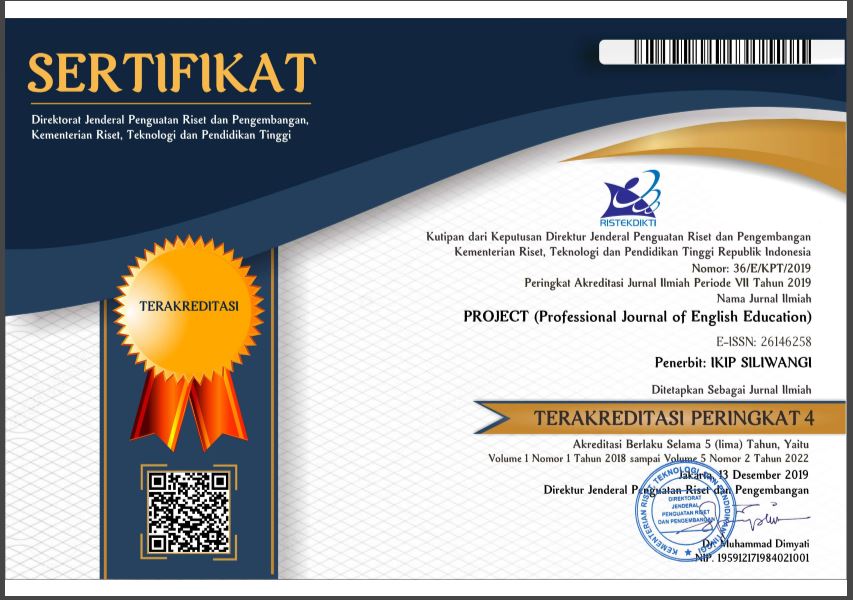Academic Writing Anxiety on Undergraduate Thesis Writing
Abstract
Academic writing anxiety is a common barrier for undergraduates, particularly during thesis writing, impacting both performance and well-being. While general writing anxiety has been studied, this research focuses specifically on thesis writing. The study aims to identify factors contributing to academic writing anxiety in students and the symptoms they experience. Using a phenomenological qualitative approach, in-depth semi-structured interviews were conducted with 12 participants from the English Language Education program at the State Islamic Institute of Palangka Raya, all of whom had taken a thesis course. The researcher adapted the SWLAI instrument for data collection and applied content analysis to interpret the results. Findings reveal that factors such as fear, high or low expectations, self-esteem, lack of ability, stress, and communication issues with lecturers contribute to anxiety. Common symptoms include physical disturbances and avoidance behaviors. The results of this research findings are expected to be a consideration for various parties to arrange the best way to prevent or handle anxiety in the implementation of thesis writing as a final project.
References
Aloairdhi, N. M. (2019). Writing Anxiety Among Saudi Female Learners at Some Saudi Universities. English Language Teaching, 12(9), 55. https://doi.org/10.5539/elt.v12n9p55
Ayton, D., Tsindos, T., & Berkovic, D. (with Open Textbook Library). (2024). Qualitative Research: A practical guide for health and social care researchers and practitioners. Monash University.
Bouzioti, D. (2023). Introducing the Phenomenological Model of Performance Practice (PMPP): Phenomenological Research Design and the Lived Experience in Performance. International Journal of Qualitative Methods, 22, 16094069231211142. https://doi.org/10.1177/16094069231211142
Cheng, Y.-S. (2004). A measure of second language writing anxiety: Scale development and preliminary validation. Journal of Second Language Writing, 13(4), 313–335. https://doi.org/10.1016/j.jslw.2004.07.001
Eagleson, C., Hayes, S., Mathews, A., Perman, G., & Hirsch, C. R. (2016). The power of positive thinking: Pathological worry is reduced by thought replacement in Generalized Anxiety Disorder. Behaviour Research and Therapy, 78, 13–18. https://doi.org/10.1016/j.brat.2015.12.017
Garcia, G. L., Moral, M., Rocete, A. R., Ilagan, M., Cabido, J. C., Escueta, H. G., Novilla, K. J., & Retone, L. (2023). Influence of Social Pressures on the Academic Performance of HUMSS Students at NU-Nazareth. Edukasiana: Jurnal Inovasi Pendidikan, 3(1), 57–87. https://doi.org/10.56916/ejip.v3i1.496
Gwyer, P. (2017). Applying the Yerkes-Dodson law to understanding “Positive” or “Negative” emotions. https://doi.org/10.13140/RG.2.2.17750.55367
Hasibuan, J. R. (2014). The Effects of Technology on Writing. 3(1).
Hsu, J. L., & Goldsmith, G. R. (2021). Instructor Strategies to Alleviate Stress and Anxiety among College and University STEM Students. CBE—Life Sciences Education, 20(1), es1. https://doi.org/10.1187/cbe.20-08-0189
Hu, P., Lu, Y., Pan, B.-X., & Zhang, W.-H. (2022). New Insights into the Pivotal Role of the Amygdala in Inflammation-Related Depression and Anxiety Disorder. International Journal of Molecular Sciences, 23(19), 11076. https://doi.org/10.3390/ijms231911076
Kawengian, G. E., & Subekti, A. S. (2024). “I’m Afraid My Thesis Has Many Mistakes”: Thesis Writing Anxiety, Its Contributing Factors, and Alleviating Strategies. Journal of English Teaching and Learning Issues, 7(1), 17. https://doi.org/10.21043/jetli.v7i1.21632
Kurniawati, A., & Atmojo, A. E. P. (2022). EFL thesis writing anxiety: Causes, effects, and coping strategies. EnJourMe (English Journal of Merdeka) : Culture, Language, and Teaching of English, 7(2), 137–151. https://doi.org/10.26905/enjourme.v7i2.8004
Lebow, H. I. (2022, June 24). What Are the 5 Types of Avoidance Behavior? Psychcentral. https://psychcentral.com/health/types-of-avoidance-behavior
Liu, J., & Huang, P. (2021). Evaluation and Analysis of Student Academic Burden: A Global Perspective. Science Insights Education Frontiers, 10(2), 1423–1437. https://doi.org/10.15354/sief.21.or062
Liu, Y. (2020). The Effect of Sentence-Making Practice on Adult EFL Learners’ Writing Anxiety A Comparative Study. English Language Teaching, 13(6), 34. https://doi.org/10.5539/elt.v13n6p34
Mirawdali, S., Morrissey, H., & Ball, P. (2018). Academic Anxiety and Its Effects on Academic Performance. International Journal of Current Research, 10.
Nawawi, A. R., Nirwanto, R., & Widiastuty, H. (2024). A Study on EFL Students’ Writing Anxiety (A Case Study Of The Indonesian Students). 7(1).
Pramiastuti, O., Rejeki, D. S., & Pratiwi, A. (2020). Pengenalan Dan Pelatihan Sitasi Karya Ilmiah Menggunakan Aplikasi Mendeley. JABI: Jurnal Abdimas Bhakti Indonesia, 1(1), 24–30. https://doi.org/10.36308/abp.v1i1.178
Quvanch, Z., & Si Na, K. (2022). Evaluating Afghanistan University students’ writing anxiety in English class: An empirical research. Cogent Education, 9(1), 2040697. https://doi.org/10.1080/2331186X.2022.2040697
Sabti, A. A., Md Rashid, S., Nimehchisalem, V., & Darmi, R. (2019). The Impact of Writing Anxiety, Writing Achievement Motivation, and Writing Self-Efficacy on Writing Performance: A Correlational Study of Iraqi Tertiary EFL Learners. SAGE Open, 9(4), 215824401989428. https://doi.org/10.1177/2158244019894289
Shiri, M., Akhavan, S., & Gerami, N. (2012). Anxiety Disorder and Its Types. In V. Olisah (Ed.), Essential Notes in Psychiatry. InTech. https://doi.org/10.5772/37525
Wern, T. C., & Rahmat, N. H. (2021). An Investigative Study on The Types and Causes of ESL Writing Anxiety: A Case Study of Learners From A Chinese Independent Middle School. European Journal of English Language Teaching, 6(3). https://doi.org/10.46827/ejel.v6i3.3553
Downloads
Published
Issue
Section
License

This work is licensed under a Creative Commons Attribution-ShareAlike 4.0 International License.




